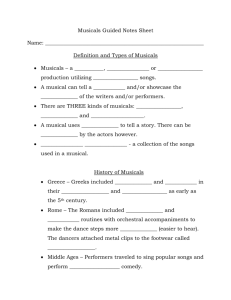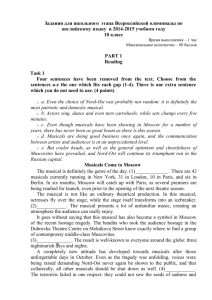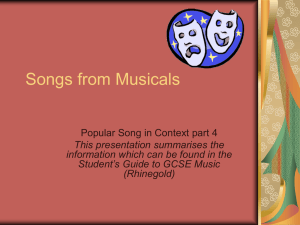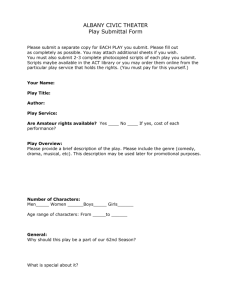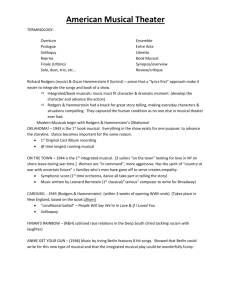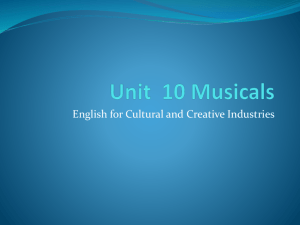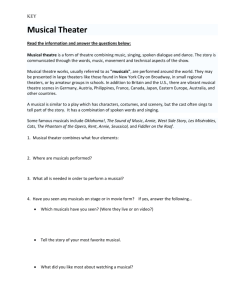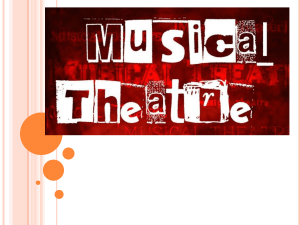Musicals
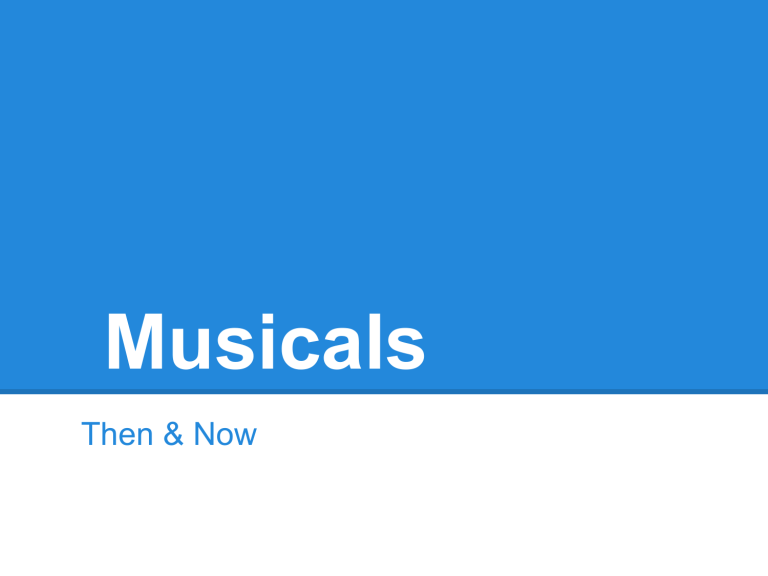
Musicals
Then & Now
Back in the Day
-Musical theater elements go back to Greek theater when music and dance were important aspects of a performance.
-Tap dance started with the Greeks- They would put metal on the bottom of their shoes so their dancing would be more audible in those large omni theaters
-The Christian Church also used musical theater aspects as a means to tell their stories
But we’re going to focus on 1800-present
Types of Musical
- Book Musical- what we are most accustomed to now, music with a strong story that drives the play
-Revue- A collection of songs, generally with a common element present
(Ziegfeld's Follies)
Types of Musicals cont.
-Concept Musical: the concept or message is just as important, if not more than the story
(Rent)
-Jukebox Musical: using only songs from a group or artist (Jersey Boys)
-Rock/Pop Musical: rock or pop with little to no dialogue (Hair)
19th Century Musical Theater
Gilbert & Sullivan
-British writer and composer
-These two were the ones who future composers and writers looked to as a model for integrating words and music together almost seamlessly, to move the plot forward.
“Pirates of Penzance” opened in NYC in attempts to save the theater district
19th Century Musical Theater cont.
-Opera was still the common form of musical performance pieces for the most part
-But change was happening all around
-NYC and London had set themselves up as major theater districts
19th Century Musical Theater cont.
How’s this for a show? It’s called “Mikado”
The characters’ names are:
Pitty-Sing, Yum-Yum, Nanki-Poo, & Pish-Tush
Early 20th Century Musical Theater
-Vaudeville Theater
In the early 1900’s, people used the theater as an escapist experience from the realities of war
In the 20’s, the shows began to highlight key actors, big routines, and songs in lieu of the plot
-Many shows were revues
“Showboat” in 1927, was another stepping stone towards musical theater today
Showboat
I’ll give you a dollar if you can sing like this:
20th Century Musicals cont.
-The 1930s light-hearted musicals held on through the depression as well as the booming movie industry
-194060 “The Golden Age”
Rodgers & Hammerstein had finally come together and “Oklahoma” was born.
Quickly followed by “Carousel,” “South
Pacific,” “The King and I,” and “The Sound of
Music”
Traits of Golden Age Musicals
The formula for the Golden Age musicals reflected one or more of four widely-held perceptions of the "American dream": That stability and worth derives from a love relationship sanctioned and restricted by Protestant ideals of marriage
; that a married couple should make a moral home with children away from the city in a suburb or small town; that the woman's function was as homemaker and mother ; and that Americans incorporate an independent and pioneering spirit or that their success is self-made
Golden Age Musicals
Big choreographed dance numbers
Follow gender roles closely
As far as content goes, definitely “school appropriate”
The go-to shows for schools to put on
Golden Age Musicals Examples:
Annie
The Music Man
Annie Get Your Gun
Bye Bye Birdie
Oklahoma
Damn Yankees
Showboat
The Fantasticks
Music
Guys and Dolls
Pacific
My Fair Lady
Sound of
South
Bye Bye Birdie “Telephone Hour”
The 1970s
The Decade of Rock Musicals
Jesus Christ Superstar, Hair, The Rocky Horror
Picture Show, Godspell
There was also a significant African-American impact on Broadway with: Dreamgirls, The
Wiz, Purlie
1975, A Chorus Line
Pippin, Chicago, & Cabaret utilized the old
Vaudeville style
Rocky Horror Picture Show
“Time Warp”
The 1980s
Influence from Europe with “mega musicals” or
“pop musicals” big casts, big effects, and big budgets
Les Miserables, Phantom of the Opera, Cats,
Little Shop of Horrors
Andrew Lloyd Webber is the musical man of
80s
The large budgets of the shows were redefining what financial success on Broadway meant-from a few shows running to a few years of shows running
Les Miserables
“Do You Hear the People Sing”
The 1990s
New Composers and writers were emerging
As well as Disney’s presence on Broadway
Rent debuted and pulled the young crowd back into musicals
Disney also brought out The Lion King, Beauty and the Beast, and Aida
Again, big shows, big budgets
But also a comeback from the little guys
Beauty & The Beast “Human
Again”
The 2000s
Bring on the new and unusual!
Avenue Q (puppets), Urinetown (being poor),
Spring Awakening(nudity/profanity/sex),
Wicked(the before of Wizard of Oz),
Hairspray(remake of Jon Waters’ movie),
Legally Blonde(remake of movie)
A reuse of film plots
Making musicals out of plots of hits from artists
Jersey Boys (Frankie Vallie, Movin’ Out (Billy
Joel), Mamma Mia (ABBA)
Hairspray“Good Morning
Baltimore”
So How BIG are Musicals?
Last season, Broadway grossed
$1,139,000,000
46 new productions opened
11.57 million people went to see the shows
TOURING SHOWS:
$877,000,000
13.7 million viewers
Average Ticket Price: $40-$200
